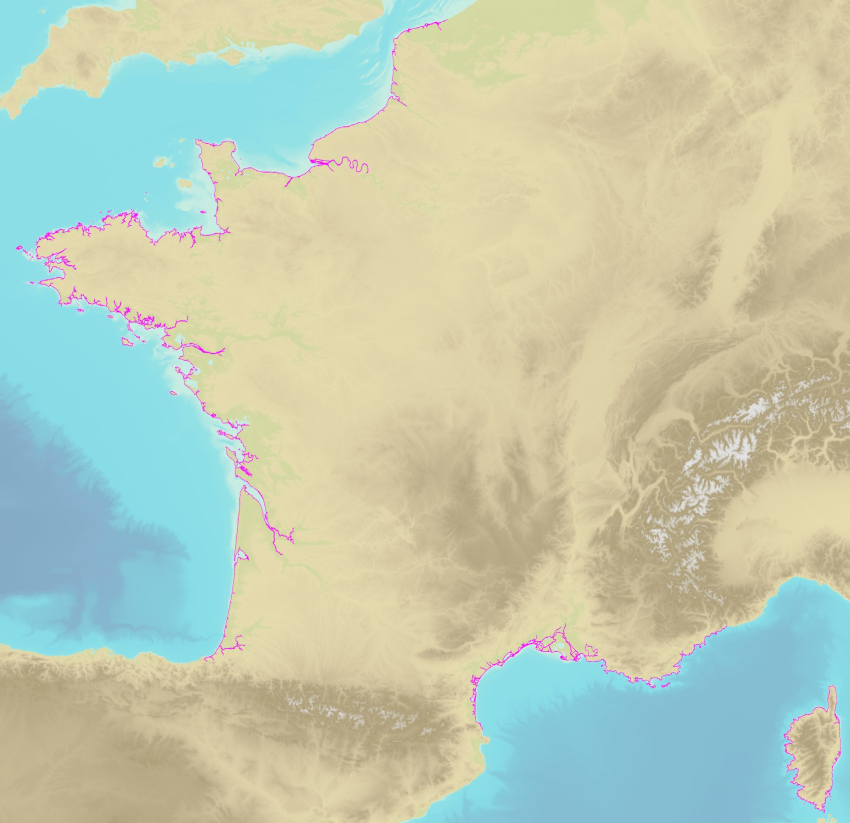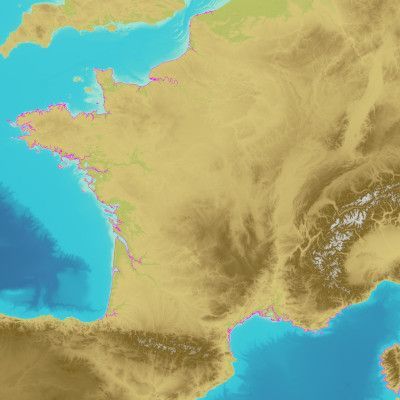2000
Type of resources
Available actions
Topics
Keywords
Provided by
Years
Formats
Representation types
Update frequencies
status
Scale
Resolution
-

The land-sea limit corresponds to the Highest Astronomical Tide (HAT) in the case of a tide of coefficient 120 and under normal meteorological conditions (no offshore wind and mean atmospheric pressure of 1013 hPa). This geometric line is naturally defined as the intersection of a HAT model (extended to the coast and the top end of the upper estuary) based on the available Bathyelli surfaces, and a high-resolution digital terrain model of the coastal area. It corresponds to the highest limit of the intertidal area and takes into account, when they exist, the 3 administrative maritime limits which are: the transversal limit of the sea (LTM), the salt water limit (LSE) and the limit of maritime jurisdiction (LAM). This limit is measured (quoted) in relation to the local hydrographic chart datum and to the levels of reference for France (IGN69 and IGN78 for Corsica). Relations to other levels of reference (mean sea level and ellipsoid) are known. The land-sea limit product, mainly results from the exploitation of the two products Litto3D®/RGEALTI® and Bathyelli, and represents, with a metric resolution (1 to 5 metres), this theoretical entity by a set of 2D polylines describing the nature of the coast (artificial or natural, rocky or sandy, steep or flat, etc.). The method used for calculating the land-sea limit makes it possible to produce a continuous, homogeneous and spatially coherent limit on the entire French metropolitan coastal area.
-

The land-sea limit corresponds to the Highest Astronomical Tide (HAT) in the case of a tide of coefficient 120 and under normal meteorological conditions (no offshore wind and mean atmospheric pressure of 1013 hPa). This geometric line is naturally defined as the intersection of a HAT model (extended to the coast and the top end of the upper estuary) based on the available Bathyelli surfaces, and a high-resolution digital terrain model of the coastal area. It corresponds to the highest limit of the intertidal area and takes into account, when they exist, the 3 administrative maritime limits which are: the transversal limit of the sea (LTM), the salt water limit (LSE) and the limit of maritime jurisdiction (LAM). This limit is measured (quoted) in relation to the local hydrographic chart datum and to the levels of reference for France (IGN69 and IGN78 for Corsica). Relations to other levels of reference (mean sea level and ellipsoid) are known. The land-sea limit product, mainly results from the exploitation of the two products Litto3D®/RGEALTI® and Bathyelli, and represents, with a metric resolution (1 to 5 metres), this theoretical entity by a set of 2D polylines describing the nature of the coast (artificial or natural, rocky or sandy, steep or flat, etc.). The method used for calculating the land-sea limit makes it possible to produce a continuous, homogeneous and spatially coherent limit on the entire French metropolitan coastal area.
-
Ce jeu de données est une représentation uniforme de territoire de Bordeaux Métropole par mailles hexagonales de 250 mètre (espacement horizontal et vertical), mobilisable pour la production d'indicateurs territoriaux.
-
Ce jeu de données représente sous forme de ponctuels les dispositifs destinés à protéger le réseau d'eau potable contre des sous-pressions ou des surpressions.
-
Plan Local d'Urbanisme (PLU) numérisé. Ce lot informe du droit à bâtir sur la commune de PEUJARD. Ce PLU est numérisé conformément aux prescriptions nationales du CNIG.
-

Ce jeu de données recense les églises et chapelles sur le territoire du Parc naturel régional des Landes de Gascogne, détermine leur type, leur époque, leur statut de protection et leur état de conservation.
-
Carte Communale (CC) numérisée. Ce lot informe du droit à bâtir sur la commune de ISSIGEAC. Cette CC est numérisée conformément aux prescriptions nationales du CNIG.
-

Réalisation de la photo-interprétation assistée par ordinateur (PIAO) de l'occupation du sol du territoire du littoral Aquitain couvrant 9 SCOT. Le SCOT de Bayonne fait l'objet d'une interprétation plus fine. Une nomenclature repondant aux exigences européennnes et nationale Une nomenclature emboitée à 4 niveaux et 56 postes a été définie. Elle est basée sur la nomenclature européenne CORINE LAND COVER. Cette nomenclature a été adaptée au territoire aquitain après analyse et remontée des besoins par les partenaires.
-
Carte Communale (CC) numérisée. Ce lot informe du droit à bâtir sur la commune de LA BOISSIERE D'ANS. Cette CC est numérisée conformément aux prescriptions nationales du CNIG.
-
Cadastre labellisé DGI pour 6 communes de la Communauté de Communes Nive Adour : LAHONCE,MOUGUERRE,SAINT-PIERRE-D'IRUBE,URCUIT,URT,VILLEFRANQUE. Référent Administratif = CDC
 Catalogue PIGMA
Catalogue PIGMA